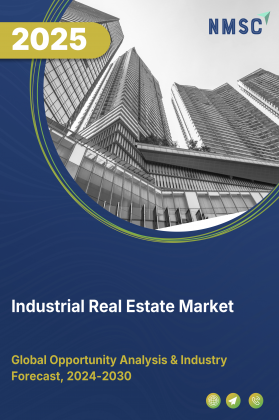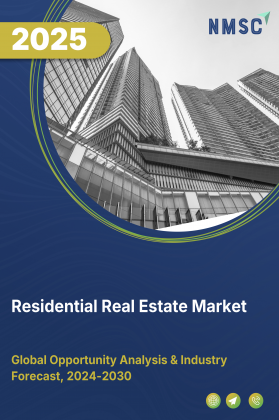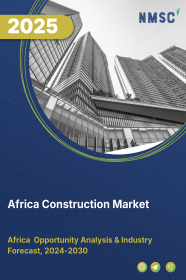
Industrial Real Estate Market by Property Type (Warehousing & Logistics, Manufacturing Facilities, Specialized Industrial Assets), by Property Size (Small Facilities, Medium Facilities and Others), by Ownership (Owner-Occupied Facilities, Leased Facilities and Others), by Tenant Type (Single-Tenant Industrial Properties, Multi-Tenant Industrial Properties), by Business Activity (Buying, Selling, Leasing and Others)– Global Opportunity Analysis and Industry Forecast, 2025–2030
Industry Outlook
The global Industrial Real Estate Market size was valued at USD 319.02 billion in 2024, with an estimation of USD 335.77 billion in 2025 and is predicted to reach USD 433.66 billion by 2030 with a CAGR of 5.25% from 2025-2030.
The market is witnessing robust growth, driven by the rapid expansion of e-commerce, logistics, and urbanization, which are increasing demand for strategically located warehouses, distribution centers, and fulfillment hubs. Adoption of advanced automation, robotics, and AI-powered warehouse systems is further fueling demand for technologically equipped, high-tech industrial facilities.
At the same time, limited availability of development-ready land and reliable power infrastructure poses challenges, restricting expansion and raising development costs. Emerging opportunities in sustainable and eco-friendly industrial spaces are encouraging investment in green facilities, offering premium returns and aligning with corporate sustainability goals. Overall, the industrial real estate market is evolving to meet the needs of efficient, resilient, and environmentally conscious supply chains.
Growth of E-Commerce and Logistics Drives the Market Expansion
The rapid growth of e-commerce and logistics is a major driver of the industrial real estate market growth. Increasing online shopping and consumer demand for faster deliveries have created a strong need for modern warehouses, distribution centers, and fulfillment hubs.
Companies are actively seeking strategically located industrial spaces to optimize supply chains, improve last-mile delivery efficiency, and support large-scale inventory management, thereby boosting demand and investment in the sector.
Rapid Urbanization Boosts the Market Growth
Rapid urbanization is a key driver of the industrial real estate market expansion, as growing city populations increase demand for strategically located industrial and logistics facilities. According to the World Bank, in 2024, the urban population in India and the U.S. accounted for 37% and 84% of their total populations, respectively.
This trend compels businesses to establish warehouses, distribution centers, and manufacturing units closer to urban centers to reduce transportation costs, shorten delivery times, and enhance supply chain efficiency. Furthermore, expanding urban areas spur the development of new industrial zones and infrastructure, creating additional investment opportunities in industrial real estate to meet the needs of a rapidly urbanizing consumer base.
Increasing Adoption of Automation Fuels the Market Demand
The increasing adoption of automation is a major driver of the industrial real estate market demand. Advanced technologies such as robotics, automated storage and retrieval systems, and AI-powered warehouse management are transforming industrial operations.
Companies now require modern, technologically equipped industrial facilities to accommodate these automated systems, improving operational efficiency, reducing labor costs, and enhancing supply chain reliability. As a result, demand for smart, flexible, and high-tech industrial spaces is rising, driving growth in the industrial real estate sector.
Land And Power Shortages Challenges the Market Growth
The industrial real estate market is increasingly constrained by the limited availability of development-ready land and reliable power infrastructure. As demand for modern logistics and manufacturing facilities grows, suitable sites near major consumption hubs are becoming harder to secure, while rising energy requirements from advanced industries create additional strain on existing grids. These shortages lead to delays in project execution, higher development costs, and restricted expansion opportunities, acting as a significant restraint on the overall growth of the sector.
Adoption of Green and Sustainable Industrial Facilities Creates New Growth Opportunities
Sustainability and environmental considerations are creating new opportunities in the industrial real estate market trends. Companies are increasingly seeking eco-friendly warehouses and manufacturing facilities equipped with energy-efficient systems, renewable energy sources, and sustainable building designs.
Developing “green” industrial spaces not only meets regulatory and corporate social responsibility requirements but also attracts tenants willing to pay a premium for environmentally responsible facilities, presenting developers and investors with a growing niche in the market.
Market Segmentation and Scope of Study
The industrial real estate market report is divided on the basis of property type, property size, ownership, tenant type, business activity, end user, and region. On the basis of property type, the market is grouped into warehousing and logistics, manufacturing facilities, and specialized industrial assets. On the basis of property size, the market is categorized into small facilities, medium facilities, large facilities, and mega facilities. On the basis of ownership, the market is segmented into owner-occupied facilities, leased facilities, and joint ventures and co-ownership models. On the basis of business activity, the market is divided into buying, selling, leasing, renting, and industrial real estate investment. Regional breakdown and analysis of each of the aforesaid segments includes regions comprising of Asia-Pacific, North America, Europe, and RoW.
Geographical Analysis
The growth of construction activities is a significant driver of the industrial real estate market share in North America. According to the U.S. Census Bureau, construction spending in June 2025 was estimated at a seasonally adjusted annual rate of USD 2,136.2 billion, highlighting robust investment in commercial, and infrastructure projects.
This surge in construction activity increases demand for warehouses, distribution centers, and industrial parks to store materials, equipment, and supplies. Developers and investors are responding by building modern, strategically located industrial facilities to support construction supply chains, streamline logistics, and ensure timely project execution, thereby driving growth in the region’s market.
In Europe, the growing emphasis on sustainability and environmentally friendly operations is driving demand in the market. Companies are increasingly seeking “green” warehouses and logistics facilities equipped with energy-efficient systems, renewable energy sources, and eco-friendly building designs. This trend is fuelled by stringent EU regulations on carbon emissions and corporate sustainability targets, encouraging developers to invest in modern, sustainable industrial spaces that meet both regulatory requirements and tenant demand for environmentally responsible facilities.
Asia-Pacific is emerging as one of the most dynamic regions in the market, fuelled by rapid e-commerce growth and expanding manufacturing supply chains. According to India Brand Equity Foundation (IBEF), in 2024–25, e-commerce became a major driver of start-up investments in India, attracting USD 3.1 billion across 79 deals, representing 31% of total start-up funding.
Global retailers are scaling up logistics hubs, while regional developers are accelerating investments in modern warehouses and infrastructure. These initiatives are reshaping the industrial real estate landscape, creating advanced facilities that enable faster distribution and more resilient supply chains. Consequently, the Asia-Pacific region is well-positioned to lead global market growth in the coming years.
In the Rest of the World, including regions such as Latin America, the Middle East, and Africa, government policies and investments in industrial infrastructure are key drivers of the industrial real estate market. Development of special economic zones, industrial parks, and improved transport networks enables companies to establish manufacturing units and logistics hubs more efficiently. Supportive regulations, tax incentives, and streamlined approvals attract both domestic and foreign investors, boosting demand for modern, strategically located industrial facilities across these regions.
Strategic Innovations Adopted by Key Players
Key players in the industrial real estate industry are accelerating global expansion through large-scale logistics developments, digital infrastructure investments, and strategic partnerships.
-
In March, 2025, SEGRO, the UK’s leading specialist in logistics property, has teamed up with Pure Data Centres Group (Pure DC), backed by Oaktree Capital, to launch a 50:50 joint venture to develop London's first fully fitted data centre at Park Royal. The venture represents a strategic pivot from SEGRO’s long-standing “powered shell” model toward delivering turnkey, high-performance facilities tailored to hyperscaler tenants like Amazon or Microsoft.
-
In March 2024, ESR Australia and Frasers Property Industrial have formed a 50:50 joint venture to acquire a sprawling 64.4-hectare land parcel from Salta Properties, located at 635 Hall Road, Cranbourne in Melbourne’s south-east. The partners plan to develop the site into a premium industrial estate, with development works slated to begin in late 2024 and the first buildings expected to be completed by 2026. This high-quality precinct will also include small-lot subdivisions available for sale, adding flexibility to the site’s future use. The project underscores both firms’ commitment to expanding in high-growth logistics markets and meeting rising demand for modern industrial facilities.
Key Benefits
-
The report provides quantitative analysis and estimations of the sector from 2025 to 2030, that assists in identifying the prevailing industrial real estate market opportunities.
-
The study comprises a deep-dive analysis of the current and future industrial real estate market trends to depict prevalent investment pockets in the industry.
-
Information related to key drivers, restraints, and opportunities and their impact on the market is provided in the report.
-
Competitive analysis of the players, along with their market share is provided in the report.
-
SWOT analysis and Porters Five Forces model is elaborated in the study.
-
Value chain analysis in the market study provides a clear picture of roles of stakeholders.
Industrial Real Estate Market Key Segments
By Property Type
-
Warehousing & Logistics
-
Warehouse & Fulfillment Centers
-
Last-Mile Delivery Hubs
-
Cold Storage Facilities
-
Industrial Outdoor Storage
-
-
Manufacturing Facilities
-
Heavy Manufacturing Plants
-
Light Assembly Units
-
Advanced Manufacturing
-
Food & Beverage Processing Units
-
-
Specialized Industrial Assets
-
Data Centers
-
R&D Facilities
-
Flex Industrial Spaces
-
Showroom Industrial
-
Industrial Parks
-
By Property Size
-
Small Facilities
-
Medium Facilities
-
Large Facilities
-
Mega Facilities
By Ownership
-
Owner-Occupied Facilities
-
Leased
-
Joint Ventures & Co-Ownership Models
By Tenant Type
-
Single-Tenant Industrial Properties
-
Multi-Tenant Industrial Properties
By Business Activity
-
Buying
-
Selling
-
Leasing
-
Renting
-
Industrial Real Estate Investment
-
Direct Property Investment
-
Industrial REITs
-
By End User
-
Business Entities
-
Startups
-
SMEs (Small and Medium Enterprises)
-
Large Corporations
-
Multinational Companies (MNCs)
-
E-commerce & Logistics Companies
-
-
Government
By Region
-
North America
-
The U.S
-
Canada
-
Mexico
-
-
Europe
-
The UK
-
Germany
-
France
-
Italy
-
Spain
-
Denmark
-
Netherlands
-
Finland
-
Sweden
-
Norway
-
Russia
-
Rest of Europe
-
-
Asia-Pacific
-
China
-
Japan
-
India
-
South Korea
-
Australia
-
Indonesia
-
Singapore
-
Taiwan
-
Thailand
-
Rest of Asia-Pacific
-
-
Rest of the World
-
Latin America
-
Middle East
-
Africa
-
Key Players
-
ESR Group Limited
-
GLP
-
SEGRO plc
-
CTP N.V.
-
VGP N.V.
-
Link Logistics Real Estate
-
Panattoni Development Company
-
Rexford Industrial Realty
-
First Industrial Realty Trust
-
EastGroup Properties
-
STAG Industrial
-
Mapletree Logistics Trust
-
Frasers Property Industrial
Report Scope and Segmentation:
|
Parameters |
Details |
|
Market Size in 2025 |
USD 335.77 Billion |
|
Revenue Forecast in 2030 |
USD 433.66 Billion |
|
Growth Rate |
CAGR of 5.25% from 2025 to 2030 |
|
Analysis Period |
2024–2030 |
|
Base Year Considered |
2024 |
|
Forecast Period |
2025–2030 |
|
Market Size Estimation |
Billion (USD) |
|
Growth Factors |
|
|
Countries Covered |
28 |
|
Companies Profiled |
15 |
|
Market Share |
Available for 10 companies |
|
Customization Scope |
Free customization (equivalent to up to 80 working hours of analysts) after purchase. Addition or alteration to country, regional, and segment scope. |
|
Pricing and Purchase Options |
Avail customized purchase options to meet your exact research needs. |

















 Speak to Our Analyst
Speak to Our Analyst























